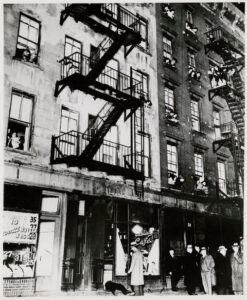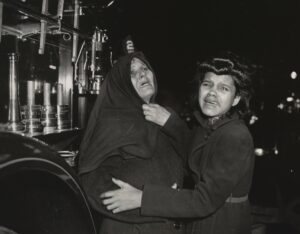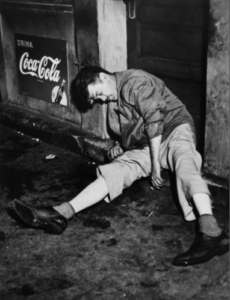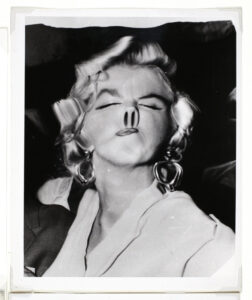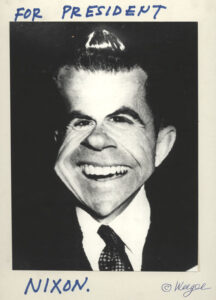Translator : Ravita Buaphuan
Is crime scene photography considered as art?
A person jumping off a building, getting hit by a car, being burned or murdered – as commoners, we tend to look away from these horrifying scenarios instead of looking for its beauty. It is regular that these scenes are censored on newspaper pages.
But for one photographer who had been active in New York City from the 1930s – 1940s, he managed to portray these violent scenarios in such an artistic manner.
His photography does not only capture the victims or the crime that happened, it also shows the reactions from the crime witnesses whether the thrill of the crowd or the curiosity of the passerby, which sometimes presented with satirical humor, or triggered emotions from the audience.
There is no wonder why his works are said to be so “human”.
Every night this man would go hunting for photos, do everything to arrive at the scene as quickly as possible, even before the police sometimes. He thereby got a nickname “Weegee” meaning “Ouija”.
The Normal Hero would like to introduce “Arthur Fellig” or “Weegee”, a legendary journalist photographer who had such an extreme reckless life, one of the first persons that could entirely change the perspective towards crime scene photography.
01 The Ouija of Darkness
“News photography teaches you to think fast, to be sure of yourself, self-confidence. When you go out on a story, you don’t go back for another sitting. You gotta get it.” – Weegee
The United States, New York City in the 1930s was full of delinquents, ethnic immigrants and illegal businesses. These factors could bring about disputes and crimes every single day, especially in the night that was out of police sight.
In the midst of decaying society, Weegee at the age of 36 unthinkably found an opportunity. He bought a camera and wandered around to take photos of violent scenes including accidents, and sold them to various tabloids.
The man grew up in a poor family without a good education background, making his life difficult to make ends meet. Getting money from selling crime photos could keep him alive.
Weegee worked mostly at night, slept in the day and woke up at 9PM.
He chose to rent a cheap apartment with no lift and water heater, but located at the back of Manhattan Police Headquarters. When the time comes, he would grab his trusty camera and rush to the station to be on the watch at once.
When he started taking journalist photos in 1935, the officers would use a telex machine to report news to each other, and after that a short-wave police radio was developed. Weegee would come to the station, listen to the cases reported, hopped in his car and drove off when he heard something. The routine went on for two years until the officers gave him a radio. Weegee would keep it playing in his car or next to his bed almost all the time. It is not surprising that the photographer would often arrive at the scene before the police.
- Arrests made during a gambling raid in lower Manhattan’s Liberty Street, October 1942
- Victory in Europe day celebrated in Chinatown, 1945
“My car became my second home. I kept everything there, my camera, a flashlight bulb, a typewriter, boots, cigar box, infrared film, also extra shoes and socks. Since I got the radio, I was no longer attached to the teletype of the police headquarters. I got my own wings to fly.”
There is no record of who named him “Weegee” but the name rendered from Ouija Board, which might refer to how he appeared at the scene so quickly, as if he was summoned there.
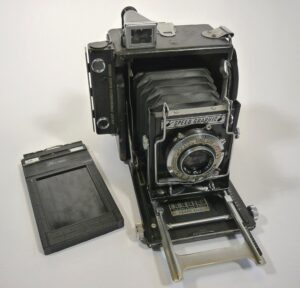
Weegee’s Speed Graphic Camera
A 4×5 Speed Graphic camera with flashbulb and cigar box were his trusty equipment. His flash would shine blazing through darkness, completely capturing all the details in the frame. Weegee would work until dawn and come back to develop his films in the darkroom of his apartment, making reports. Some even said he would just develop his films at the back of his car.
Weegee was an independent photographer. He would wait until morning to sell photos to newspaper editors or photographic agencies, then go back to sleep and wake up again at 9PM. This routine repeated everyday. It might not be exaggerating to say that he was working recklessly.
In the era that most photographers were labeled, what he did was quite strange for the outsiders’ perspectives.
“I wouldn’t wait ’til somebody give me a job or something, I would go and create a job for myself”
Though being commonly known as “Weegee”, his real name was Arthur Felig. His motherland, which nowadays became a part of Ukraine, was in Austria.
His father migrated to The United States first, followed by his mother and their children. By that time the 10-year-old boy still used his old name “Usher” but the immigration officer misspelled it as “Arthur” giving him an American name from that moment on.
Weegee’s family was not wealthy. Thus he tried to look for jobs and found out about the street photographer, who can gain money from taking photos of people passing by. He then tried to find a camera and follow such a path.
During that time the cameras have become extensively available. An expensive giant camera in a studio became a cheaper portable camera. Still, not that everyone would afford them. That was when the career of freelance photographer emerged in New York. Nevertheless Weegee had a different way of gaining money. He bought a donkey and took it over the street on holidays, searched for well-dressed kids and invited them to ride the donkey, then he would take a photo of them, process and go to their parents houses to sell the photos. This is how the young man managed to get by.
His passion in the world behind shutter grew as he kept doing so. Arthur became an assistant in a photography studio for traveling books before getting hired as a technician for the darkroom of the New York Times.
At the age of 24, Weegee joined ACME News Pictures (later became UPI Photos) and began to get assigned to take photos when other photographers were not available. However, after years gone by, his works were still not widely recognized. He decided to become an independent news photographer to fully release his creativity.
And that was the beginning of a one-of-a-kind journalist photographer life.
02 Crime Journalism and Humanity
It can be said that there was no photographer who could capture such horrifying murders, scandals and the catastrophes of New York City between the 1930s and 1940s as much as Weegee did.
Throughout 12 years working as a freelance photographer, Weegee had captured more than 5,000 murder cases, changed his cars for 5 times and 10 for his cameras.
His works are notably standout. Some look extremely crude and violent, portraying the reality before his eyes such as corpses, burned corpses or a car-hit injured in which the audiences can feel terrified.
At the same time, a number of his works are embedded with humor, critique of class inequality, or reactions that reflect the essence of humanity like fear, curiosity and relief.
“I tried to take photos of the scenes without including blood, or take photos of a corpse from an angle that doesn’t look too horrible. Actually I’m very sensitive and artistic and hate the sight of blood, but I’m spellbound by the mystery of murder”
- “Balcony seats at a murder.” Nov. 16, 1939.
- Tenement Fire, 1939
One of his famous works is the photo of a man being shot on 16 November 1939, published on LIFE. The crime scene was in an Italian neighborhood. The dead lay covered with blood in front of a café. Weegee saw that there were at least 5 things going on, the residents in the buildings looking down through windows, the crowd watching from a fire escape ladder, the kids reading cartoons, the forensic police working and the rest of photographers focusing on the dead.
Weegee chose to step back from those scenarios and shot it with a wide-angle lens and flash. The photo therefore contains various stories, reflecting the emotions people had towards such a violent incident.
“I saw the scenario and thought of it as a scene from a play, so I named it “Balcony Seats at a Murder”. It was my intention to create news with humanity. That photo brought me the gold medal prize. Of course, I had a problem with my editor who didn’t understand it.”
Another photo was a fire incident. Instead of taking photos of raging flames like other photographers did at that time, Weegee took a shot of a surviving mother and her kid. But both of them were crying in despair because the firefighters could not save her other kid and niece.
“I cried while taking this photo,” he admitted.
It was this kind of sensational images that became his signature and started to bring him fame.
And not just cruelty, Weegee sometimes put humor into his works too.
- ‘Simply Add Boiling Water’: a fire in the Ameko building near Brooklyn Bridge, December 1943
- ‘Drink Coca Cola’
A photo of fire catching on a 7-floor building near Brooklyn bridge, with an eye-catching billboard that said ‘Simply Add Boiling Water’ collocating with the firefighters who were spraying water to extinguish the fire. These details got the audience to think, frankly, as if those officers were following the instruction from the billboard. Another one is a photo of a drunk guy sleeping next to a Coca-Cola vending machine that got us thinking that he got drunk out of drinking the black soda.
During that time, this type of image was extremely extraordinary. Most photographers would only take photos of important scenes that tell the incident straightforwardly for that it responds to the demand of newspapers better. Weegee was lucky to have the editor that understood him and saw the value of his works, because if it was other persons, his photos would have been thrown away.
In a radio show that he has given an interview, the MC really admired his photos, saying that they look rather creepy. But Weegee rejected it. He said he wanted his photographs to show humanity – It’s human. He believed that photos which portray humanity would create something special.
Weegee was once asked for the techniques he used to pull off such striking photos. He answered “f/8 and be there” means a camera with a setting of aperture at 8, which has ISO that is high enough to capture all the subject. And being there, if there is anything happening you would definitely get a photo, because no matter how good your camera is, it means nothing if you are not in the right place and time.
“For me, a beautiful photo should preserve significant moments of life. I have always been asked about how I managed to get that lifelike quality in my pictures. ’Very simply,’ I’d reply. ‘I see a good picture and I snap it.’”
Nevertheless, his photography was not only about crime and death. When he found something interesting or have a chance to make the front page, Weegee would capture it too, as well as a photo of people being happy
“I usually choose stories that contain some kind of meaning, in other words, that will make news.”
“Please do not think that I like to photograph violence. When I was at Coney island, I took a photo of a young couple walking, holding hands too. I like to photograph people in a nice moment. But this is my job, what else could I do?”
03 From Taking Shots of The Dead to Photographing Celebrities
Weegee spent 12 years in the crime photojournalism circle, before making a decision to abandon this path.
By that time, he had his works published in a large number of publications that MOMA (Museum Of Modern Art) started to compile and exhibit his works.
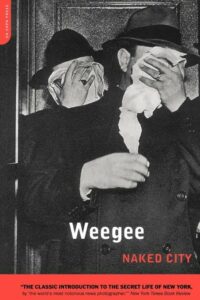
In 1945, he launched his first book “Naked City” which was later adapted into a film “The Naked City”. The book brought him explosive popularity and granted him a chance to work as an advertising photographer for major magazines like Vogue, Life, Look and Holiday.
He decided to move to Hollywood and became a photographic consultant in a film set, also received commission to take still shots in a film set. One of those who admired his works is Stanley Kubrick, who asked him to take behind-the-scenes photos for his film ‘Dr. Strangelove’.
- MARILYN MONROE, Weegee
- FOR PRESIDENT NIXON, Weegee
- President John F. Kennedy
One interesting thing is that, as he changed to photograph stars and celebrities like Marilyn Monroe, Richard Nixon and John F. Kennedy, he would use special lenses that distort their faces. It can be said that Weegee always had innovative ways of taking photos.
However, Weegee had never returned to crime photography throughout his life. It could be just as he said, he did not like to photograph violence, but he had to do it to make a living.
But undeniably, his news photos taken during the 1930s – 1940s have become an inspiration for a lot of people, especially documentary photographers and street photographers. And they are still being studied over and over until nowadays.
REFERENCES
– weegeeweegeeweegee.net
– siamstreetnerds.com
– Podcast ศิลปะการต่อสู้ | EP.30 | Weegee The Cloud



